The Kalinago Barana Aute
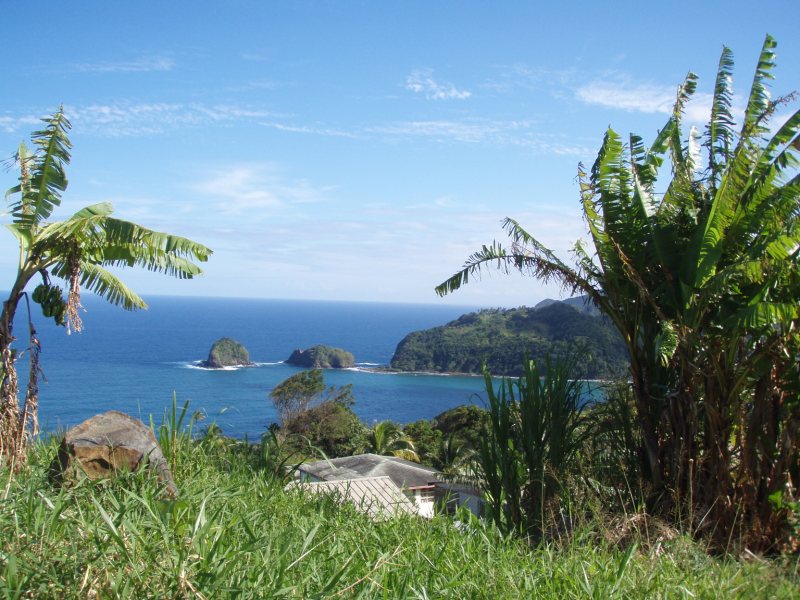
After a picnic
on the coast we went in search of the Carib Village.
 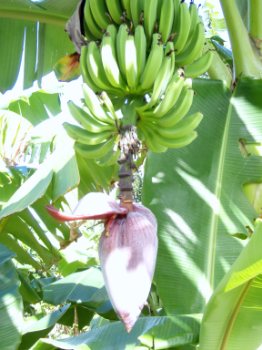 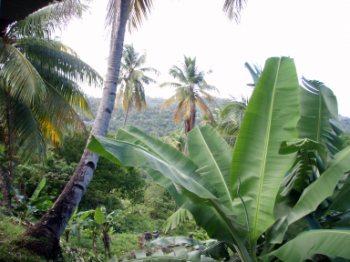
Bear in the car as Roger, Sasha and I went off to talk to a
lady about the differences between plantain and banana, she introduced a new
species altogether, the cockqui, we left her even
more confounded. A
couple of wrong turns asking various people we met along the way, eventually we
found it. The Kalinago Barana Aute (The Carib Cultural Village) which
offers an opportunity to see and learn the authentic heritage of the last
remaining Kalinago People of the Caribbean. We had a young tour guide who showed
us around. We saw basket weaving, cassava bread baking, fish being smoked
and various medicinal plants and trees were pointed out with their uses
explained.
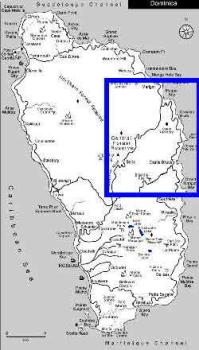
Dominica was the name given to 289.8 square miles of
land by Christopher Columbus, when he landed on the island on November 3rd 1493.
On the north eastern side of this beautiful tropical rainforest island is
3782.03 acres of land set aside known as the Carib Territory. It is situated
between two villages, Atkinson to the North and Castle Bruce to the South. It is
the home of approximately 2208 Kalinagos (Caribs), the remaining survivors of
the first inhabitants of the island. The people called the island Waitukubuli
(tall is her body), and they referred to themselves Kalinagos. The Europeans
referred to them as Caribs.
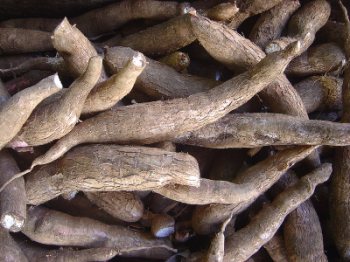 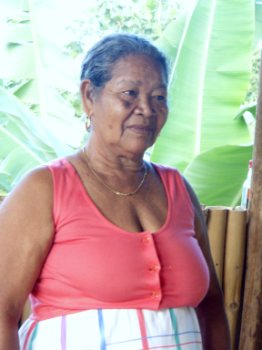 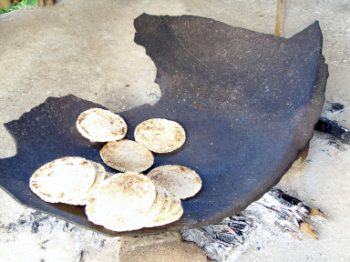
Before we entered the village we saw this Carib lady on the cliff road baking. The cassava, cassada,
yuca, manioc, mogoor mandioca (Manihot esculenta) is a woody shrub of the spurge
family native to South America that is extensively cultivated as an annual crop
in tropical and subtropical regions for its edible starchy tuberous root a major
source of carbohydrate. Cassava is the third largest source of carbohydrates for
human food in the world, with Africa its largest centre of production. The flour
made of the roots is called tapioca. In the islands of the Eastern Caribbean,
cassava is traditionally peeled and boiled and served with flour dumplings and
other root vegetables like potatoes, yams, sweet potatoes and dasheen. The
softly boiled root has a delicate flavour and can replace boiled potatoes in
many meals, or deep fried it is rather like chips. Cassava leaves are a good
source of protein if supplemented with methionine despite containing cyanide. We
bought two breads, very heavy, with the texture of rough coconut, quite chewy
but pleased we tried it.

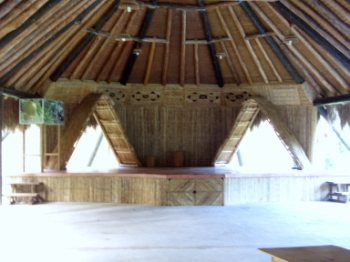 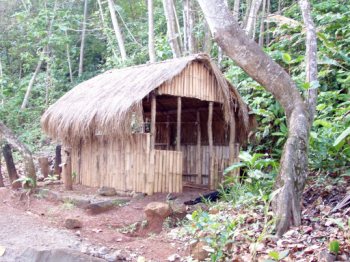
The Karbet or men's quarters. Inside
beautiful construction. A small hut or Mwina.
The Caribs and Colonial forces. For more than
two centuries, colonial forces attempted to gain control of the island but the
Kalinagos met them with fierce resistance. Due to the inaccessibility of
the coastline and the rugged terrain of the island, the Kalinagos managed to
repel the invaders. The island changed hands many times but still the Kalinagos
defended their lands. In 1748, under the treaty of Aix-La- Chapel, Britain and
France recognized the Kalinago domination of the island and declared it to be
neutral and left it under Kalinago control. This treaty was short lived. The
British continued to wage war on the Kalinago people but due to their courage
and bravery they survived. In 1763, the British gained full control of Dominica.
The Kalinagos were given 232 acres of mountainous and rocky shoreline in
Salybia. In 1903, the amount of land was expanded to 3700 acres and was called
the Carib Reserve; in addition the Carib Chief was officially
recognized. Before the arrival of Christopher Columbus the Kalinagos were
self-reliant people. They survived mainly by fishing, hunting, and farming. They
were skilled craft people and made canoes hewn from Gommier trees; which were
used to travel to and from the neighboring islands. The Caribs also weaved
baskets and were famous for their herbal medicine. They spoke their own language
and worshipped the Spirit of their ancestors. The Carib Council officially has
the custody, management and control of the Reserve, for and on the behalf of the
residents of the Reserve. The first chief was Jules Benjamin Corriette from 1916
to 1926. The chief was allowed twelve wives all other men six, by arranged
marriage with one of the other seven villages.
  
If the villagers are suffering from bad dreams, the chief comes
down to where the river and sea touch. He bathes in
herbs and the dreams abate. It is believed that the Kalinago people transported
the Larouma plant to Dominica from South America over 1000 years ago. As part of
the culture of the Kalinago people, the plant was passed on from past to present
generations and they nurtured the skills and creativity to weave extremely
beautiful, valuable and functional craft from it. These products include:
bottles, baskets, caps and hats, sifter, squeezer, mats and finger traps today
still weaved by hand. The calabash have creative and traditional carvings on
them which were made by the Kalinagos. The calabash can be used for eating
utensils or for decorations, like on St Lucia the fruit is inedible. Calabash is
widely used by the Kalinagos and Dominican in general.

 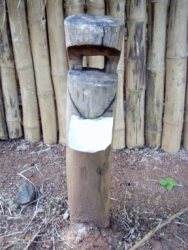 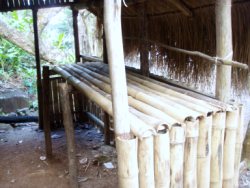
The candle plant - its leaves are
stripped and the stalk is placed in the candle holder. Sugar
cane crusher, a work bench in a hut.
Carib, Island Carib or Kalinago people, after
whom the Caribbean Sea was named, live in the Lesser
Antilles islands. They are an Amerindian people whose origins lie in the southern West
Indes and the northern coast of South America.
Although the men spoke either a Carib language or a pidgin, the Caribs' raids resulted in so many female
Arawak captives that it was not uncommon for the
women to speak Kalhiphona, a Maipurean
language - Arawakan. In the southern Caribbean they co-existed with a
related Cariban-speaking group, the Galibi, who lived in separate villages in
Grenada and Tobago and are believed to have been mainland
Caribs.
  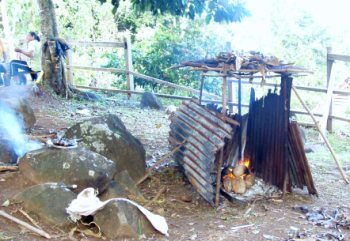
The path down to the village. A modern Carib, made us laugh, with her Woolworth grater and
mobile phone. Fish smoking in heated rocks and the
source of fire for the village.
History
The Caribs are believed to have left the Orinoco
River area in South America to settle in the
Caribbean. Over the century leading up to
Columbus' arrival in the Caribbean archipelago in 1492, the Caribs are believed
to have displaced the Maipurean-speaking Arawaks who settled the island chains earlier in history. The
islanders also traded with the Eastern Taino of the Caribbean Islands. The Caribs were the source of the
silver which de Leon found in the
possession of the Taíno; gold was not smelted by any of the insular Amerindians,
but rather was obtained by trade from the mainland. The Caribs were skilled boat
builders and sailors, and seem to have owed their dominance in the Caribbean
basin to their mastery of the arts of war. The Caribs were themselves displaced
by the Europeans, and most were eventually killed in battle, assimilated during
the colonial period, or retained areas such as on
Dominica.
The Black Caribs, Garifuna of St
Vincent inherit their ethnicity from a group of black slaves
who were marooned in a 1675 shipwreck possibly
after seizing power from the crew. In 1795, they were deported to
Roatan Island, off
Honduras, where their descendants, the Garífuna,
still live today. Carib resistance delayed the settlement of Dominica by
Europeans, and the Carib communities that remained in St. Vincent and Dominica
retained a degree of autonomy well into the 19th century. The last known
speakers of Island Carib died in the 1920s.
 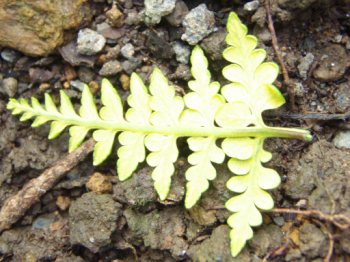 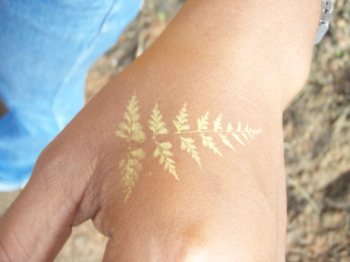
The humble fern, its underside and having been pressed onto our guides' hand.
Religion
The Caribs are believed to have been polytheists (worship of
more than one God). That was not known by Columbus,
or any other European. The reason for their invasion was to convert the Caribs,
whom they thought were Pagans, to Catholicism. The Kalinago religion was a
simple adaptation of the ancestor worship of the Taino. They believed in an evil
spirit called Maybouya who had to be placated in order to avoid harm. The chief
function of their shamans, called boyez, was to heal the sick with herbs and to
cast spells (piai) which would keep Maybouya at bay. The boyez were very
important and underwent special training instead of becoming warriors. As they
were held to be the only people who could avert evil, they were treated with
great respect. Their ceremonies were accompanied with sacrifices. As with the
Arawaks, tobacco played a large part in
these religious rites.
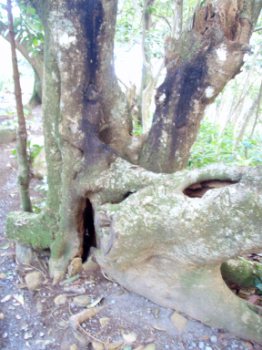  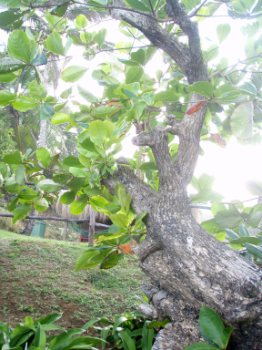
The Caconier tree grows hollow, the
spirits whisper in them and they are used to make drums. Our guide breaking open
an almond, soft, succulent and not at all like eating
them from a supermarket. The almond tree felled by Hurricane
David, but alive and well at a jaunty angle. Sasha has a Bay Leaf tucked
in her T-shirt to protect her from the whispering spirits. These Bay leaves have
a much stronger aroma of incense than what we grow in the UK for
stews.
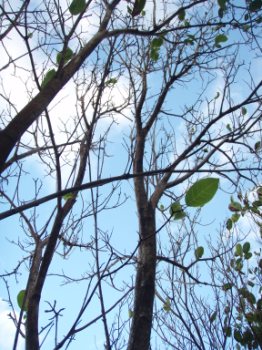 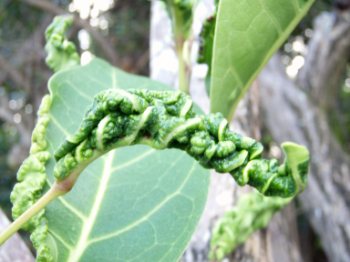 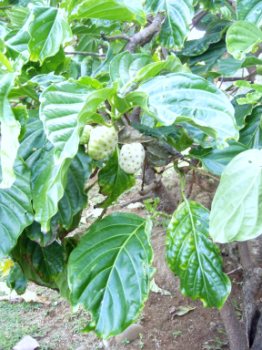
The white cedar, used for furniture. The young leaf of the tree protects itself by looking dead
and deformed. The Noni or Morinda Citrifloia is used
for blood pressure, diabetes, prostate trouble and to settle the
stomach.
Kalinago Myths - MARUKA AND CIMANARI
At that time there lived in Salybia two brothers called Maruka
and Cimanari, famous for the charms they made. They would go up to the house of
the master Tete Chien - the same who when the earth was soft, made the
stairway of the Tete Chien at Sineku. He is a giant snake, has a crest of
diamonds on his head and crows just like a cockerel. When they found him, they
would burn powdered tobacco before him on the blade of a paddle. Then the
Tete Chien would vomit - " l'envers caraibe". Then the snake would
disappear gradually, and in his place came a young man "sans cullote" (naked).
The young man said nothing about being the Tete Chien, but asked Maruka
and Cimanari what they wanted, he then instructed them how to use the
l'envers caraibe to make their charms.
Maruka and Cimanari did not die in Salybia. When they felt old
age approaching they returned to the 'other country'. When they reached the
shores of the Orinoco River, they plunged into the stream, when they
climbed out on the opposite banks, they became two young lads again, on the
water where they had been floated two turtle shells. They never came back to
Dominica, at last one of them died; but the other is still living
there.
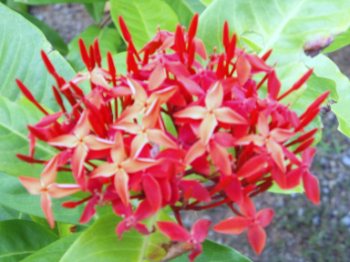
 
THE SPIRIT OF THE ROCK
On the extremity of a narrow ridge opposite and beyond Bataka
is perched a huge rock, 60 feet in height, that overlooks the valley of
Pagua, the Ocean and the Reserve. It is a blackish, crumbling rock, on its
summit and from its precipitous sides grow vines and plants, a stunted scrub,
and a kind of wild orchid. It is known as La Roche Pagua, and is the home of a
benevolent spirit about whom many tales are told. The people of Bataka used to
go up the Pagua rock in search of charms. There are steps leading to the base of
the rock and on its top, a crack that goes through the inside. That is where the
Zombie lives, if ever you see him it means someone is going to die soon. On
the top of the rock there grew all manner of charms, but in particular a
white flower with so sweet a smell, that people passing on the highway at the
foot of the cliff may easily catch the fragrance. When it is flowering, a new
blossom comes on every hour of the day and every hour another fades and falls.
If you are lucky enough to find one of these flowers, you may
command whoever you wish. You only have to rub on the palm of your hand,
raise your hand in the direction of a person and call their name, however far
they may be, they will have to obey and come to you. If you go in quest of the
flower, it is wise to take with you a white cock, or at least some powdered
tobacco, as a gift to the spirit of the rock.
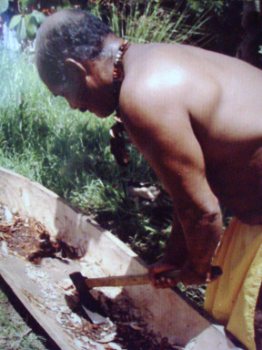  
A canoe maker, a spirit and an ancient
relative.
Patriarchy
Early Carib culture, as seen from a distance, appears
especially patriachal. Women carried out primarily domestic duties
and farming, and in the 17th century lived in separate houses (a custom which
also suggests South American origin) from men. However, women were highly
revered and held substantial socio-political power. The local
self-government unit may have been the
longhouse dwellings populated by men or women, typically run by
one or more chieftains reporting to an island
council. Many people seem, however, to believe that the Carib
women held no purpose other than to produce offspring. Boys were more hoped for
so that they would be able to become a warrior.
 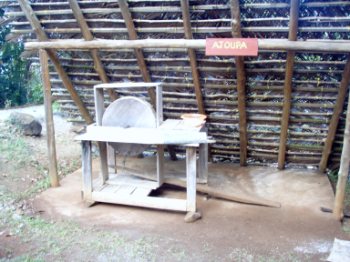 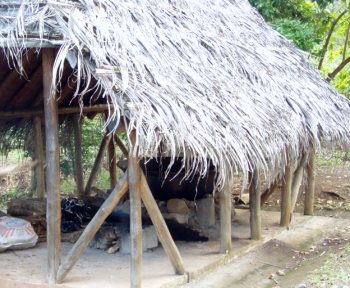
This tree provides brooms from tying the
leaves together, the fruit makes toothbrushes. Or as
Bear said Dentistree. I'll slap his legs
later. Ajoupa means sunshade, small sloping - single
sided shelters, the first providing cover for the grinder, the second covering a
cooking pot.
Cannibalism
Instances of cannibalism are said to have been noted as
a feature of war rituals: the limbs of victims may have been taken home as
trophies. While the Kalinago would chew and spit out one mouthful of flesh of a
very brave warrior, so that his bravery would go to him, there is no evidence
that they ate humans to satisfy hunger. The Kalinago also had a tradition of
keeping the bones of their ancestors in their houses; initially this had been
taken as evidence that they ate human flesh. Missionaries such as Pere Jean
Baptiste Labat and Cesar de Rochefort described the Kalinago practice of preserving the bones
of their ancestors in their houses in the belief that the ancestral spirits
would always look after the bones and protect their descendants. Even after
Columbus was presented with evidence that the cannibalism of the indigenous
people was a myth, the myth was perpetuated because in 1503, Queen
Isabella ruled that only people who were better off
under slavery (including cannibals) could legally be taken as slaves. This
provided Spaniards an incentive and legalistic pretext for identifying various
Amerindian groups as cannibals in order to enslave them and take their lands
away from them. To this day the Kalinago people fight against what they regard
as a misconception about their ancestors. The film Pirates of the Caribbean:
Dead Man's Chest was recently criticised by the National
Garifuna Council for portraying the Carib people as cannibals.
 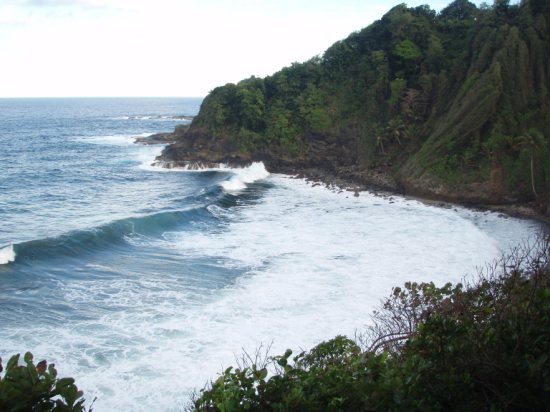
Bear, Roger, Sasha and our guide stop to take in
the view.
On the East Coast of Dominica, the native Dominicans live in
peace and harmony. They are the most of their kind living together, the second
inhabitants of the island after the Ciboneys. Unfortunately, due to inaccurate
accounts written about them, Caribs have been regarded for many years as "fierce
and warlike." However, any encounter with the Caribs, would quickly change one's
mind. "Gentle" seems to be their generic trait. They are uncomplicated people
who rely on the earth and the sea for a living.
When Christopher Columbus
landed in Dominica in 1493 with his men and his ships in search of gold and
fortune, they were dismayed to find only rivers, rich volcanic soil, mountains
and the Caribs! The Caribs had settled on Dominica, but their ancestors had come
from South America: down the Orinoco river and then up the Caribbean Sea where
they settled on the most rugged of the islands in order to protect themselves
from enemies. The Caribs welcomed Columbus and his men and in return Columbus
worked them, almost to the verge of extinction.

ALL IN ALL the Kalinago people
didn’t mind Columbus landing or leaving, they just weren't pleased to see him
back with settlers. A people we
warmed to
immediately.
|










































